Fantasia 2016, Day 18, Part 2: Commitment to Genre (Before I Wake and The Top Secret: Murder in Mind)
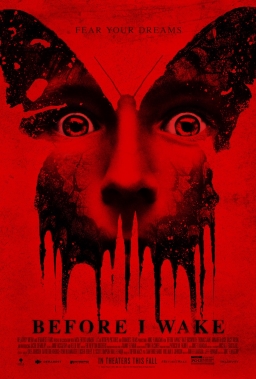 As the evening of Sunday, July 31, began I was looking forward to two films I planned to see at the Hall Theatre. The directors of both movies had interesting track records. Before I Wake, following the strange events surrounding an orphan boy whose dreams cross over into reality, was a new film from Oculus director Mike Flanagan. After that would come The Top Secret: Murder in Mind (Himitsu the Top Secret), a science-fiction murder mystery from Keishi Otomo, maker of the Rurouni Kenshin historical samurai-steampunk movies. One of these two films would (more or less) live up to my expectations.
As the evening of Sunday, July 31, began I was looking forward to two films I planned to see at the Hall Theatre. The directors of both movies had interesting track records. Before I Wake, following the strange events surrounding an orphan boy whose dreams cross over into reality, was a new film from Oculus director Mike Flanagan. After that would come The Top Secret: Murder in Mind (Himitsu the Top Secret), a science-fiction murder mystery from Keishi Otomo, maker of the Rurouni Kenshin historical samurai-steampunk movies. One of these two films would (more or less) live up to my expectations.
First came a short film called “Quenottes” (“Pearlies”), written by Pascal Thiebaux and directed by Thiebaux with Gil Pinheiro, in which a boy (Matthieu Clément-Lescop) losing the last of his baby teeth brings out the supernatural mouse that hoards old lost teeth. A nastier version of the Tooth Fairy, the mouse cannot be cheated of its bounty, and this causes problems for the boy and his father (Lionel Abelanski). An excellent soundtrack helps the story move sharply along to a final disaster. The film’s an effective horror short with the feel of an old unDisneyfied fairy tale.
Before I Wake is a story about a married couple, Jessie and Mark (Kate Bosworth and Thomas Jane) who adopt an orphaned eight-year-old boy, Cody (Jacob Tremblay). Cody seems like a perfect child, but he’s had problems with previous foster families. We soon learn the boy has a psychic gift that makes his dreams come to life for so long as he’s asleep. His nightmares have killed already, so Cody’s doing all he can to stay awake as long as he can. But he can’t keep his eyes open forever.
Usually when there’s a question-and-answer session after a film I report it after giving my impressions of the movie. This is one of those cases, though, where the comments of the creators have such a direct relevance to what I thought of the film that I want to present them first. What follows, as always, comes from handwritten notes (possibly inaccurate in specifics though I believe generally representative of the gist of things) recording the the comments of director Mike Flanagan, star Kate Bosworth, and Producer Trevor Macy.
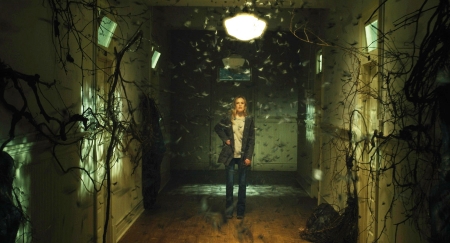 Flanagan was asked first about how he discussed the mourning process through genre films, to which he said that for him genre was an opportunity to explore the darker and more painful sides of nature. Originally Before I Wake was titled Somnia, and would have made the third piece in a thematic trilogy following Absentia and Oculus, as the scripts for all three movies were written within a few months of each other. Asked about Bosworth’s involvement, Flanagan recalled that she came onto the film in 2013, and spent a lot of time with him preparing the film. Bosworth said that she had been excited by the grounded aspect of the film, and its attention to human relationships. Flanagan observed that the genre elements of the movie were a “delivery system for a story,” and were meant to enhance the character-oriented aspect.
Flanagan was asked first about how he discussed the mourning process through genre films, to which he said that for him genre was an opportunity to explore the darker and more painful sides of nature. Originally Before I Wake was titled Somnia, and would have made the third piece in a thematic trilogy following Absentia and Oculus, as the scripts for all three movies were written within a few months of each other. Asked about Bosworth’s involvement, Flanagan recalled that she came onto the film in 2013, and spent a lot of time with him preparing the film. Bosworth said that she had been excited by the grounded aspect of the film, and its attention to human relationships. Flanagan observed that the genre elements of the movie were a “delivery system for a story,” and were meant to enhance the character-oriented aspect.
Asked how the project got off the ground, Macy spoke about the importance of working on the character backgrounds, using genre as a way into character. Asked about how Tremblay got involved, Flanagan noted that he was brought on before Tremblay was cast in Room, that he brought a sympathetic quality that seemed to instill a desire in viewers to protect him, and that while Flanagan had been intending to cast an 11- or 12-year-old to play 8-year-old Cody, Tremblay was actually 6 when he was cast and had to play older (Tremblay began the movie with his baby teeth, which had worked themselves out by the end of filming). Bosworth said Tremblay was very open as an actor, and remembering her start at 14, remarked how impressed she was with him. Flanagan noted that Tremblay and one of the other main child actors on the film had been honestly scared of the monster in the film, played by a contortionist in a mask; he dealt with that fear by letting the kids play with the mask on its own, after which they were fine.
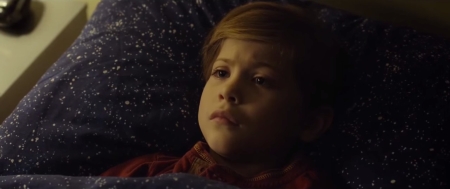 Asked about a scene involving the death of Jessie and Mark’s biological son, Flanagan observed that it legitimately hurt him — he filmed it with his own son, and at one point Flanagan’s “heart just exploded.” Asked about some of the plot details in the film, Flanagan said that he felt explaining “whys,” especially in genre pieces, take away from the movie. Whatever answer a filmmaker comes up with tends not to be good enough. Evil, he said, doesn’t have an answer. Try to answer those questions and you end up dedicating your whole movie to the questions. He couldn’t explain, for example, why Cody could manifest his dreams. Ambiguity, he said, creates tension, while explanations relax tension.
Asked about a scene involving the death of Jessie and Mark’s biological son, Flanagan observed that it legitimately hurt him — he filmed it with his own son, and at one point Flanagan’s “heart just exploded.” Asked about some of the plot details in the film, Flanagan said that he felt explaining “whys,” especially in genre pieces, take away from the movie. Whatever answer a filmmaker comes up with tends not to be good enough. Evil, he said, doesn’t have an answer. Try to answer those questions and you end up dedicating your whole movie to the questions. He couldn’t explain, for example, why Cody could manifest his dreams. Ambiguity, he said, creates tension, while explanations relax tension.
A questioner in the audience asked why he used the image of butterflies, which in one of Cody’s dreams become crossed with christmas-tree lights to become fluttering glows of colour. Flanagan said his son loves butterflies, leading him to come up with the “lighterflies” image. Asked if he was inspired by Pan’s Labyrinth, Flanagan said “I love Pan’s Labyrinth,” and that he’d been surprised to go to a horror film and find himself crying. He hoped to capture a fraction of that in his movie. Another question about Tremblay led to Bosworth remarking that he understood what he was doing on levels deeper than most adults, while Flanagan recalled the incredibly adult way he called to be fed a line when he blanked on it.
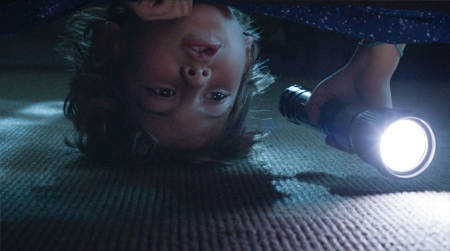 So much for the question-and-answer session. I want to draw attention here to the first and the next-to-last paragraphs above, where Flanagan and Bosworth discuss the groundedness of the film and its use of ambiguity. I will say that these things certainly come across in the finished film. But I also have to say that I felt they didn’t really work with the story onscreen.
So much for the question-and-answer session. I want to draw attention here to the first and the next-to-last paragraphs above, where Flanagan and Bosworth discuss the groundedness of the film and its use of ambiguity. I will say that these things certainly come across in the finished film. But I also have to say that I felt they didn’t really work with the story onscreen.
My interpretation of what they’re saying is that they wanted a basically realistic story against which the fantastic and horrific elements would stand in greater contrast. That makes sense, but the story of Before I Wake is fundamentally not comprehensible as realism, even beyond its fantastic elements. It’s difficult to explain this without getting too far into the weeds of plot, but: the way in which Jessie and Mark react to Cody and his gift don’t make a lot of sense. They don’t look deeply into things, they don’t tell anyone about it, and they particularly don’t warn anyone around them that strange things might be about to happen. In other words, the real reactions that one might expect flesh-and-blood people would have to such a startling thing don’t take place. Flanagan makes a good point that explaining “why” changes a story’s mood (I would say it changes things from horror to science fiction), but if you don’t have characters asking “why” when they ought to, you don’t have an emotionally grounded story.
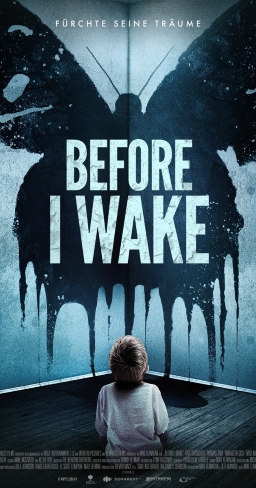 I would say this is particularly noticeable in the second half of the movie when — without wanting to get too deeply into the weeds of plot — bad things happen to Mark, and Jessie, left on her own, focusses entirely on Cody rather than on her now-missing husband. The emotional reaction feels unreal. More than that, Jessie suddenly has to launch a one-woman investigation to work out Cody’s location, which not only feels out of character but also seems improbable in terms of the realism of the story. It all makes sense from a kind of fairy-tale perspective, just as not having the characters try to understand the practicalities of Cody’s gift makes sense from a fairy-tale perspective. But it’s really the opposite of grounded. The fact that the story otherwise tries to be realistic, I would say, tends to undercut it. Had the movie been wilder, had it more deeply investigated Cody’s gift, it might have worked. As it is, the characters don’t have the heft that the filmmakers wanted to give them. In part because the fantasy elements are left underexplored.
I would say this is particularly noticeable in the second half of the movie when — without wanting to get too deeply into the weeds of plot — bad things happen to Mark, and Jessie, left on her own, focusses entirely on Cody rather than on her now-missing husband. The emotional reaction feels unreal. More than that, Jessie suddenly has to launch a one-woman investigation to work out Cody’s location, which not only feels out of character but also seems improbable in terms of the realism of the story. It all makes sense from a kind of fairy-tale perspective, just as not having the characters try to understand the practicalities of Cody’s gift makes sense from a fairy-tale perspective. But it’s really the opposite of grounded. The fact that the story otherwise tries to be realistic, I would say, tends to undercut it. Had the movie been wilder, had it more deeply investigated Cody’s gift, it might have worked. As it is, the characters don’t have the heft that the filmmakers wanted to give them. In part because the fantasy elements are left underexplored.
Consider Cody’s gift to make his dreams real. Most of the time his “dreams” turn out to be literalised memories. This is difficult to accept, as (to me) dreams and memories are very different things. There are moments of real dream-elements — a figure from a recurring nightmare, the lighterflies mentioned in the question-and-answer period — but very few. And very facile: things seen by Cody, not things that seem to really evoke his unconscious drives or fears. Conscious fears, yes, but not the weird seething stew of a person’s dream-life. Given the chance to literalise the inside of a character’s head, the movie backs away to build an unconvincing exterior.
The dream-images we do get are very few, and laboriously set up or retroactively explained. The movie’s too concerned with making things make sense, despite Flanagan’s stated desire to avoid that. The movie doesn’t really try to be a full-on horror movie, which is fair enough, but in grounding the fantasy as thoroughly as it does it also eliminates any sense of wonder or of the sublime. Notwithstanding the occasional moment of beauty, it becomes dull.
What does work, oddly, is in fact the sensory presentation of the real world: the visual groundedness of the film. Flanagan’s got an eye for architecture I find difficult to describe but which has a very real effect. Here and in the two other movies of his I’ve seen (Oculus and Hush), he’s able to shoot a house in a way that makes it feel like a real designed and built and lived-in place, a location with a history. I wouldn’t say he relies on surprising angles, more perhaps on a kind of depth of field and the slow travel of a camera along a hall or through a door; a showing of a home from the perspective of someone walking through it, maybe. Perhaps it’s relevant that he makes Mark an architect.
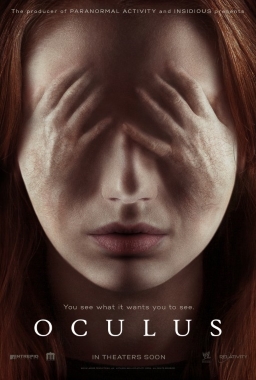 Not having seen Absentia I can’t compare Before I Wake to that movie, but I do note some similar themes to Oculus. That movie, like this, has to do with horrific forces impinging on a childhood, and with a family fragmented by the supernatural. I would also say that like this movie, it’s not entirely satisfying due to the handling of the genre material; in that case, the horrific force is too powerful. Not only is it impossible to either fight or escape the evil of the film, that evil also controls the perception of the characters to the point where it’s not always clear what’s real and what isn’t. As a viewer I found it difficult to care, as the drama seemed minimal. Again in Before I Wake I feel a certain fascination with genre elements undermined by a lack of certainty in using them.
Not having seen Absentia I can’t compare Before I Wake to that movie, but I do note some similar themes to Oculus. That movie, like this, has to do with horrific forces impinging on a childhood, and with a family fragmented by the supernatural. I would also say that like this movie, it’s not entirely satisfying due to the handling of the genre material; in that case, the horrific force is too powerful. Not only is it impossible to either fight or escape the evil of the film, that evil also controls the perception of the characters to the point where it’s not always clear what’s real and what isn’t. As a viewer I found it difficult to care, as the drama seemed minimal. Again in Before I Wake I feel a certain fascination with genre elements undermined by a lack of certainty in using them.
Again, though, it’s worth pointing out that it’s not just problems with the fantasy and horror pieces here that sink the film. The basic drama is built around a nice white upper-middle-class couple and the kind, gentle boy they adopt. It feels too idealised; for a while I found myself toying with the idea that more of the film comes out of Cody’s head than is immediately obvious — that perhaps Mark and Jessie themselves were wish-fulfillment dreams — but could find no way to make that work. There is a dreamlike feel to the movie, which further undercuts the realism of the story, but the movie then refuses to invest deeply in that dreaminess by giving the actual fantasy enough space or enough weirdness to carry the movie. There are nice moments here, but as a whole it’s a sporadically-interesting failure.
The Top Secret: Murder in Mind came next. An adaptation directed by Keishi Otomo from a script Otomo wrote with Izumi Takahashi, Lee Sork-jun, and Kim Sun-mee from the manga by Reiko Shimizu, it’s a science-fiction mystery with pronounced noir elements. I think those are tricky genres to mix, as the latter emphasises mystery and the shadowy unknown, while the former imagines a (usually) knowable world with (again, usually) a greater technological ability to know. In this case, the two genres fuse well because of the nature of the science-fictional ideas at the heart of the film. The plot gets awfully broad, if not contrived, but that’s known to happen in noir stories from time to time.
A few decades from now, young Ikko Aoki (Masaki Okada, of Strayer’s Chronicle) is a rising star among the Tokyo police investigators. His powers of observation get him recruited by Department Nine, under the command of the driven Tsuyoshi Maki (Toma Ikuta). Department Nine uses special technology, a brain-scanner that can retrieve the memories of a living or dead person from the last five years. But the process is psychologically dangerous, and the information’s not yet admissible in court. Department Nine has to prove its worth by identifying the motive behind a recent grisly crime — a man who murdered his family — but in so doing will uncover secrets reaching back much further.
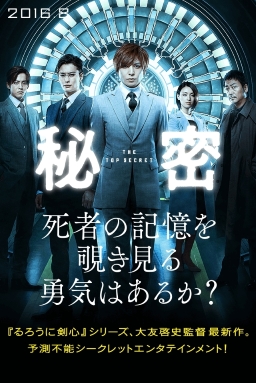 The story is complex and full of twists. Being based around memory and the exploration of memory, there’s an unusual retrospective feel: things done and things planned in the past are coming to fruition now, and it’s up to the characters to figure out what’s happening. Those characters have, I find, a tendency even beyond that to emerge and recede unexpectedly. Aoki looks like he’s going to be the main protagonist of the film, but it turns out to be Maki around whom the story revolves. This is less of a problem than it may sound, as the result is simply to keep you guessing, to emphasise the unpredictability of the tale.
The story is complex and full of twists. Being based around memory and the exploration of memory, there’s an unusual retrospective feel: things done and things planned in the past are coming to fruition now, and it’s up to the characters to figure out what’s happening. Those characters have, I find, a tendency even beyond that to emerge and recede unexpectedly. Aoki looks like he’s going to be the main protagonist of the film, but it turns out to be Maki around whom the story revolves. This is less of a problem than it may sound, as the result is simply to keep you guessing, to emphasise the unpredictability of the tale.
And the story does use memory in clever ways, finding good if occasionally improbable twists. Some memories are derived from unlikely sources. Others are buried. Sometimes the investigators must pay a price to dig them up. It works, mostly, though the ending almost can’t help but be anti-climactic. Much here is predetermined.
I note that while there are hints here about the unreliability of memories, and the difficulty of distinguishing between memory and hallucination, this isn’t Rashomon. Memories are taken as more-or-less reliable records of the past, with a few caveats that I didn’t notice affecting the plot much. This serves the clarity of the film well, but does occasionally feel simplistic. It’s a good balance: a complex plot that isn’t made over-complicated by questioning the truth of memories.
Crucially, for all the movie’s intricacy, the story arcs are always clear. So is the ever-mounting sense of pressure. The stakes rise and the characters are placed in more and more jeopardy, physical and especially mental, as the film goes on. It does what a good noir story does, setting up a brutal crime that investigators may only be able to solve at the risk of their own destruction. It isn’t terribly subtle. But its mysteries work as mysteries.
I would say it also does what a good science fiction story does, imagining new technology and a new world and the interaction between technology and world and character. The memory scanners aren’t just dropped into the world, they’re part of a hierarchy in the police force and part of interdepartmental squabbles and even the focus of fears for some. The world is shaped by the technological innovation at the centre of the story, and the characters react to that technology as the story goes on; and are changed by the way they interact with it. The actual science is minimal, but the way the movie shows people adjusting to a scientific innovation — for good or for evil — shapes the story, which in turn is about a part of humanity given new light by the nature of the imagined technology. It’s a story that says things that could not be said without a science-fictional vocabulary.
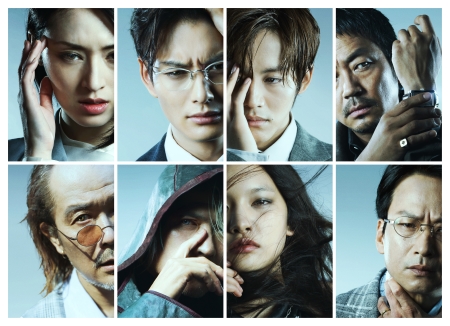 More generally, I’ll note that Otomo’s created an intriguing visual future (I have no idea how much of it is derived from either the original manga or the anime show based on the manga). The world here is slightly steampunk, engagingly low-tech and lacking in glowing holographic interfaces. Characters wear formal high-collared suits. Guns look like guns, cars like cars. Furniture has a slightly Victorian feel. But the workspace of Department Nine is filled with files and computer screens and wires and green light, today’s technology tomorrow. Colour and light is generally used well, high-tech lighting and monitor glow used to create noirish contrast.
More generally, I’ll note that Otomo’s created an intriguing visual future (I have no idea how much of it is derived from either the original manga or the anime show based on the manga). The world here is slightly steampunk, engagingly low-tech and lacking in glowing holographic interfaces. Characters wear formal high-collared suits. Guns look like guns, cars like cars. Furniture has a slightly Victorian feel. But the workspace of Department Nine is filled with files and computer screens and wires and green light, today’s technology tomorrow. Colour and light is generally used well, high-tech lighting and monitor glow used to create noirish contrast.
There is overall an impressive ability in this film to draw the audience in. The acting’s strong, helping immerse the viewer in a world where dead men’s memories solve murders. There are some loose ends, which may come from the source material or may be meant to set up a sequel. I will note that at almost two and a half hours (148 minutes) it feels long, even if no one section drags. And it is quite possible to criticise it for some facile symbolism. But then that seems to make the work — the very obviousness of the symbols making it broader, more dreamlike.
Overall, I was impressed at the visual sensibility, the complexity of the plot, and the way science fiction was integrated with a noir mystery. It’s not a perfect film — it’s occasionally over-broad, and the characters too facile despite the best efforts of the actors — but it’s a very good genre piece in two different genres. If you’re prepared to accept an intricate and occasionally laboured plot, this is well worth watching.
Director Keishi Otomo came out to take questions after the screening. Asked if it was intimidating to adapt to the screen a manga with a passionate fan base (like The Top Secret, but also like his previous project the Rurouni Kenshin films), Otomo said it was a new challenge that he enjoyed. Particularly challenging, he said, was working out how to show the inside of the human mind in The Top Secret, which took years of research. He also referred to years of research that went into Rurouni Kenshin.
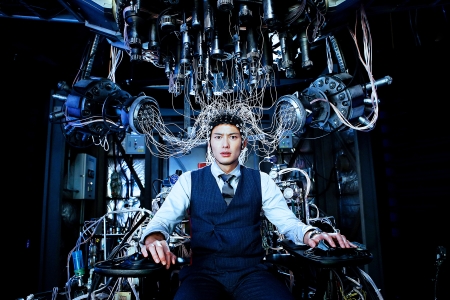 Asked about the fashions in The Top Secret, and particularly about the men’s suits, Otomo said that they’d designed all the suits specially for the film, imagining changes in fashion for the future they were creating. They believed that suits didn’t change much over time, but that even a small change would have an impact precisely because suits are so static. In response to another question Otomo noted that he’d tried to find new and old things in such elements as architecture, trying to make something new from old matter.
Asked about the fashions in The Top Secret, and particularly about the men’s suits, Otomo said that they’d designed all the suits specially for the film, imagining changes in fashion for the future they were creating. They believed that suits didn’t change much over time, but that even a small change would have an impact precisely because suits are so static. In response to another question Otomo noted that he’d tried to find new and old things in such elements as architecture, trying to make something new from old matter.
Asked about a sequel, Otomo said that a second film had been discussed but that there was also a possibility of more Rurouni Kenshin films. Asked about film references, Otomo said he wasn’t specifically conscious of any. Then asked what genre he likes more, science fiction like The Top Secret or historical films like Rurouni Kenshin, he said he likes both — and especially likes to do what he hasn’t done before. Otomo went on to say that he enjoyed mixing genres, as in Rurouni Kenshin, which was an action story but also had elements of love, horror, mystery, and drama. Otomo was asked about John Woo, and recounted meeting Woo twenty years ago in Los Angeles. Otomo said he liked many of Woo’s films, especially his 80s work, because of the way Woo stressed the importance of emotion — if a movie’s just action, he said, people aren’t moved. Woo has seen The Top Secret, and liked it.
After some joking in answer to a question of how a policeman could afford a Jaguar, Otomo was asked what themes or genres he’d like to do next. He said that his next film was already finished, a buddy movie, and he’d shot the one after that, a love story about a Japanese boy who plays chess. Asked about Catholic imagery in his movies, Otomo said that it was a deliberate choice. He’d lived for two years in Los Angeles, and wanted to know more about Christianity so had gone to church. He’d watched a lot of North American movies, and noted a lot of references to the Bible in films like 7. He found that there wasn’t the same use of religious imagery in Japanese films, not even of Buddhist imagery. In the case of The Top Secret, Otomo was struck by the way that looking into the brain was like playing god. He made the film thinking about faith and punishment, thus recalling Christianity.
Finally, Otomo was asked about adapting the visual language of manga to film. Otomo said there was a great difference in moving from two-dimensional manga imagery to three-dimensional film. Actors on film are real; they get sweaty and tired if they run. He tried to go out of the manga world, feeling that if the film was too close to the manga it wouldn’t be a good film. Still, he said, a good actor will try to look like the original character, not just visually but from the inside. He did try, he said, to keep the most important elements of the manga.
That concluded the night, with a heartfelt thanks from Otomo for seeing so many people come to his movie on the same night Radiohead was playing a show elsewhere in the city (he’d have gone to see Radiohead, he said). I left feeling I’d seen a dramatic contrast between the way two different films approached genre. Before I Wake was conscious of trying to ground genre in realism, with the result that it succeeded at neither genre nor realism. The Top Secret was very conscious of its nature as a genre film, and as such was able to talk about visionary and religious themes on top of its more obvious concerns. There seemed to be a lesson in that about committing to the form you’re using; to having the courage of your artistic convictions. If so, it’s a lesson that fits with virtually every other genre story I’ve read or seen. You have to commit to your form. Genre’s not the delivery system for a story. It is the story, or the ground for the story. The Top Secret understood that, however intuitively. Before I Wake, at whatever level, did not. This made, at least, for an interesting and instructive contrast.
(You can find links to all my Fantasia 2016 diaries here.)
Matthew David Surridge is the author of “The Word of Azrael,” from Black Gate 14. You can buy his first collection of essays, looking at some fantasy novels of the twenty-first century, here. His second collection, looking at some fantasy from the twentieth century, is here. You can find him on Facebook, or follow his Twitter account, Fell_Gard.